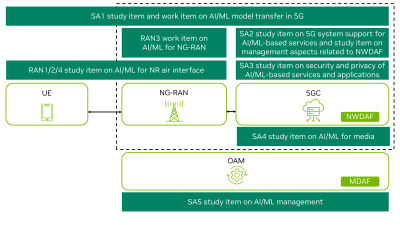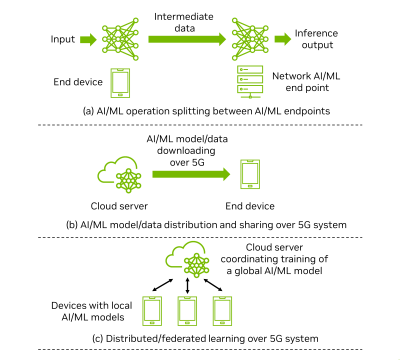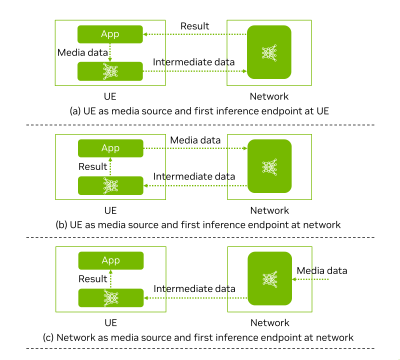Xingqin Lin
Published: 6 Sep 2023

CTN Issue: August 2023
A note from the editor:
In recent times, there has been a remarkable surge in the popularity of Artificial Intelligence and Machine Learning (AI/ML). The surge has driven various Standards Development Organizations (SDOs) to start working on ways to introduce AI/ML technologies into areas where the standards can take advantage of AI/ML to improve the overall system performance. These efforts encompass a range of areas, from catering to specialized network requirements to enhancing user experiences to simplifying network operations. The 3rd generation partnership project better known as 3GPP, is one of such SDOs that’s looking to add AI/ML technology into the development of the global standards for mobile telecommunications systems it oversees.
In this month, we are privileged to feature Xingqin Lin, a senior 3GPP standards engineer from Nvidia. Xingqin provides us with a comprehensive overview of the AI/ML developments within the “about to be completed” 3GPP Release 18, spanning multiple 3GPP groups from services to system aspects to radio access networks. We hope you enjoy this timely update.
Yingzhen Qu, CTN Associate Editor
Artificial Intelligence in 3GPP 5G-Advanced: A Survey

I. Introduction
The 3rd generation partnership project (3GPP) completed the first version of the fifth-generation (5G) specifications in Release 15 in 2018 [1] and added additional functionalities to enhance performance and address new verticals in subsequent Releases 16 and 17 [2]. 3GPP Release 18 marks the start of 5G-Advanced, which represents a major evolution of 5G system and includes comprehensive work in the area of artificial intelligence (AI)/machine learning (ML) [3][4]. AI/ML can be used to manage complex networks intelligently, address system optimization problems, and improve user experience in 5G toward the sixth-generation (6G) cellular networks. In this article, we provide an overview of the AI/ML work in 3GPP Release 18, spanning across multiple 3GPP groups from services and system aspects (SA) to radio access network (RAN).
Before Release 18, 3GPP has carried out some initial work to embrace AI/ML techniques and data analytics in 5G system design. In Release 15, 3GPP introduced network data analytics function (NWDAF) in 5G core (5GC) network [5]. NWDAF can provide analytics to consumers such as 5GC network functions (NFs) and operations, administration, and maintenance (OAM). Since then, NWDAF functionality has been enhanced in subsequent releases. In particular, Release 17 specified two NWDAF logical functions: analytics logical function (AnLF) and model training logical function (MTLF). AnLF is responsible for inference, analytics information derivation, and analytics service exposure. MTLF is responsible for AI/ML model training and exposing new training services such as providing trained AI/ML models.
In the RAN domain, an initial study on AI-enabled RAN was completed in 3GPP Release 17 [6]. The study identified high-level principles and provided a functional framework for AI-enabled RAN intelligence. The study also investigated several use cases and solutions for AI/ML in RAN, including network energy saving, load balancing, and mobility optimization.
3GPP has also introduced management data analytics function (MDAF) as part of OAM [7]. MDAF, as a key enabler for network automation and intelligence, can process data related to network status and service events to provide analytics reports. The input data can come from different types of NFs (e.g., NWDAF) or entities (e.g., next generation node B (gNB)) in the network. MDAF can be deployed at different levels, including at domain level (e.g., RAN, core network) to provide domain-specific analytics and in a centralized manner to offer end-to-end or cross-domain analytics service.
The 3GPP work on incorporating AI/ML techniques and data analytics into 5G system design conducted before Release 18 lays a solid foundation for further embracing AI/ML in 5G-Advanced evolution. Indeed, 3GPP Release 18 includes a diverse set of study and work items in the area of AI/ML, spanning across multiple 3GPP working groups, as illustrated in Fig. 1 and discussed in the rest of this article.

II. Application Layer AI/ML Operation in 5G System
3GPP study groups SA1, SA2, and SA5 have been conducting work to facilitate over-the-top application layer AI/ML operation, as described in the following three subsections, respectively.
A. AI/ML Model Transfer
AI/ML models find application in mobile devices in 5G system, e.g., image recognition, speech recognition, and video processing. It is infeasible to load all AI/ML models in user equipment (UE) in advance. Thus, downloading AI/ML models as needed is a necessity. For some applications, UE may not have sufficient computation resource to perform inference, in which case the inference operation may need to be offloaded from UE to 5G cloud or edge. Besides, training data needs to be shared across different entities that collaboratively train a global AI/ML model in 5G system.
The trend of transferring AI/ML models and data brings in new traffic type that needs to be served by the 5G system. 3GPP SA1 is responsible for identifying service and performance requirements for 3GPP systems. In Release 18, SA1 started a study to identify use cases and service and performance requirements for AI/ML model transfer over 5G system [8]. The study addressed three types of AI/ML operations which are illustrated in Fig. 2. The first operation type is AI/ML operation splitting between AI/ML endpoints. The intention of the operation splitting is to keep privacy- or latency-sensitive parts of the operation in UE but offload the computation- or energy-intensive parts of the operation to network endpoints. The second operation type is AI/ML model/data distribution and sharing over 5G system, whose purpose is to enable adaptive model downloading from a network endpoint to the devices when needed. The third operation type is distributed/federated learning over 5G system, where UEs perform partial training based on local data and a central entity trains a global model by aggregating the local results from the Ues.
The study identified potential new service requirements and key performance indicators (KPIs) for AI/ML model training, inference, downloading, monitoring, prediction, and management over 5G system. After completing the study, 3GPP SA1 continued with a follow-up work item in Release 18 to specify normative service and performance requirements for 5G system based on the potential new requirements from the study [9].

B. 5G System Support
The 3GPP SA1 work on AI/ML model transfer in 5G system identified potential new service and performance requirements, many of which are related to the support of application layer AI/ML operation in UE. 3GPP SA2, a working group responsible for developing the overall 3GPP system architecture, had completed a study in Release 18 on 5G system support to facilitate the application layer AI/ML operation [10].
3GPP SA2 has explored several possible architectural and functional extensions to support application layer AI/ML operation and concluded the study with a set of general architecture principles. One general architecture principle emphasizes that the responsibility for application layer AI/ML decisions and their internal operational logic lies with the application function (AF) and UE application client. While the network does not require knowledge of the internal workings of AI/ML services, it should have the capability to differentiate AI/ML-related traffic from other user services-related traffic. 3GPP SA2 assumes that existing detection mechanisms will be utilized to discern AI/ML-related traffic from other user services-related traffic.
One key issue studied by 3GPP SA2 is about enhancing external parameter provisioning to 5GC to facilitate application layer AI/ML operation. For the normative work, 3GPP SA2 recommends that the AF can provision the 5GC with new parameters pertaining to expected UE behavior, including confidence and/or accuracy levels of the expected UE behavior parameters, the expected inactivity time for AI/ML traffic, etc. Another key issue is 5GC information exposure to authorized third party for application layer AI/ML operation. User consent is essential for exposing UE-related information or data analytics to third parties. Uplink and downlink data rate exposure to the AF is recommended to be carried out through AF requests for data rate monitoring. 3GPP SA2 has also studied a key issue on 5G system assistance to federated learning operation. It recommends specifying a new member selection assistance functionality, which refers to the capability provided by the 5GC to generate a list of candidate Ues and additional information in response to a request from the AF. The AI/ML-based application can utilize the new member selection assistance functionality to choose federated learning members. We refer interested readers to [10] for more key issues investigated by 3GPP SA2 in Release 18.
C. Security and Privacy Aspects
The 3GPP SA2 work on 5G system support for application layer AI/ML operation described in the previous subsection identified that various AI/ML data needs to be transmitted between 5GC and AF. Some data (e.g., QoS analytics, geographical distribution information) may be user privacy sensitive and must not be exposed to an unauthorized AF. Some data (e.g., network load analytics) reflects network state and must be handled securely to prevent the data from being exploited by potential attackers. Therefore, it is critical to study security and privacy aspects of supporting application layer AI/ML operation to avoid potential threat and risk to 5G system and users.
3GPP SA3, a working group responsible for security and privacy aspects in 3GPP systems, has performed a study on security and privacy of AI/ML-based services and applications in 5G [11]. A key issue identified by the study is about privacy and authorization for 5GC assistance information exposure to AF, including determination of privacy-sensitive assistance information and methods for 5GC to protect and authorize AF to access the information. Proper privacy protection and authorization mechanisms are needed to respect user privacy and ensure network security. The study concluded that existing mechanisms (e.g., open authorization (Oauth)) can be used for authorization of 5GC assistance information exposure to AF.
III. AI/ML for Media
A vast amount of AI/ML applications are media related, such as image classification, speech recognition, and video quality enhancement. These applications require increasingly higher computational processing to handle the growing amount of AI/ML data and model complexity. Meanwhile, emerging media services such as virtual reality (VR), augmented reality (AR), and cloud gaming are taking off. Such mobile applications are processing intensive and heavily rely on AI/ML-assisted functions. For example, glass-based AR media services require context of the surrounding environment, which can be provided by using AI/ML-assisted object segmentation, recognition, and classification. AI/ML also finds application in media compression algorithms to make encoders more adaptive. Besides, the AI/ML models for the media applications require proper compression to facilitate efficient transmission. Indeed, the moving picture experts group (MPEG) has been working on deep neural network video coding to optimize media compression and on neural network representation to compress neural networks for media applications.
The aforementioned latest trends in the interplay between AI/ML and media applications call for an in-depth study to understand their impact on 5G system. Thus, 3GPP SA4, responsible for developing specifications of media codec and the system and delivery aspects of the media contents, is investigating AI/ML in 5G media services [12]. The main objective of the study is to identify relevant interoperability requirements and implementation constraints of AI/ML in 5G media services.

To start with, the 3GPP SA4 work aims to describe media-based AI/ML use cases and scenarios, based on the outcome of the 3GPP SA1 study on AI/ML model transfer that categorizes three key operations including AI/ML operation splitting, model/data distribution, and distributed/federated learning [8]. A major objective of the 3GPP SA4 study on AI/ML for media is to describe media service architecture for AI/ML and relevant service flows. To this end, one key consideration is split AI/ML inference between network and UE. Split points can depend on a number of factors including UE capabilities (e.g., memory, compute, energy consumption, and inference latency), network conditions (e.g., capacity, load, and latency), model characteristics, and user/task specific requirements (e.g., delay and privacy). Figure 3 provides an illustration of different orders of operations and the corresponding media flows for split AI/ML inference between network and UE.
Other topics under exploration in the 3GPP SA4 study on AI/ML for media include data formats and protocols for various types of data components for AI/ML-based media services, traffic characteristics of the data components delivered over 5G, KPIs, and potential areas for normative work.
IV. AI/ML Management in 5G System
AI/ML is being used across 5G system, including management and orchestration, core network, and RAN. To enable and facilitate AI/ML operation in 5G system, AI/ML models need to be created, trained, tested, deployed, and managed during its entire lifecycle. In Release 17, 3GPP conducted normative work on the management of AI/ML training [13] but that work did not cover other aspects such as AI/ML deployment and inference. Besides, AI/ML management capabilities may need to coordinate with AI/ML capabilities in core network and support AI/ML capabilities in RAN.
3GPP SA5, responsible for management, orchestration, and charging for 3GPP systems, has investigated AI/ML management to coordinate AI/ML functions across 5G system [14]. The group has studied a comprehensive list of use cases for AI/ML management and their corresponding requirements and possible solutions. It has also investigated the deployment scenarios for AI/ML training function, testing function, inference function, and the corresponding management capabilities. The training/inference function can be located in cross-domain management system or domain management system (e.g., management data analytics in MDAF), core network (e.g., network data analytics in NWDAF), and RAN (e.g., RAN intelligence in gNB). The management capabilities provided by management service producer are located in the corresponding management function.
Enhancement of the management aspects related to NWDAF has also been investigated by 3GPP SA2 in Release 18 [15]. The study identified a range of key issues, derived potential requirements for the 3GPP management system, and proposed potential solutions to tackle the identified key issues. The conclusion of the study recommended specifying enhancements to support monitoring of the data collection performance of NWDAF and facilitate deployment scenarios involving multiple NWDAFs as well as deployment scenarios that involve logical decomposition of NWDAF.
V. AI/ML for 5G Radio Access
RAN is arguably the most complex component of the cellular networks. In Release 18, 3GPP is engaging in normative work on AI-enabled RAN intelligence, as well as investigating the use of AI/ML to enhance the 5G NR air interface, to improve network performance and user experience.
A. AI/ML-enabled NG-RAN
After the completion of the Release-17 study [6], 3GPP RAN3, responsible for the overall RAN architecture and the specification of protocols for the related network interfaces, conducts normative work in Release 18 on AI-enabled RAN intelligence [16]. The primary goal of this normative work is to define enhancements for data collection and signaling support to facilitate AI/ML-based network energy saving, load balancing, and mobility optimization. These enhancements are integrated into the existing 5G RAN (a.k.a.. next-generation RAN (NG-RAN)) interfaces and architecture, encompassing both non-split architecture (i.e., monolithic gNB) and split architecture (i.e., gNB split into central unit (CU) and distributed unit (DU)). The placement of AI/ML model training and model inference can be in the OAM and gNB (or gNB-CU for split architecture), respectively, or both functions can be located within the gNB (or gNB-CU for split architecture).
In contrast to traditional measurement-based processes in the 3GPP specifications, AI-enabled RAN intelligence relies extensively on predictive capabilities, which are exchanged among gNBs via the Xn interface. These predictions encompass various aspects, such as predicted cell-level UE trajectory and predicted resource status. For instance, the cell-level UE trajectory prediction entails a list of cells where the UE is anticipated to be located in the future, along with the corresponding expected duration of stay in each cell. Additionally, feedback information that indicates the impact of AI/ML-based operations on RAN performance can be exchanged among gNBs. This feedback information encompasses UE performance metrics and energy efficiency measurements. To facilitate the exchange of such information for AI-enabled RAN intelligence among gNBs, new signaling procedures are being introduced for the Xn interface.
B. AI/ML for 5G Air Interface
AI-native air interface is anticipated to be a key feature of 6G. Therefore, it is essential to promptly initiate study on the integration of AI/ML technologies into the existing 5G air interface. This early investigation will aid in preparing for the standardization of 6G, which is scheduled to commence within 3GPP around 2025. The 3GPP Release-18 study item on AI/ML for NR air interface marks a significant milestone in the evolution of cellular networks, as it is the first time such an approach has been taken [17]. A main objective of the study item is to establish a comprehensive framework for enhancing the air interface through the application of AI/ML. Several key aspects are currently under exploration, including the definition of AI/ML algorithm stages, levels of collaboration between gNB and UE, the necessary datasets for AI/ML model training, validation, and testing, as well as the life cycle management of AI/ML models.
The study item focuses on three specific use cases, serving as pilot scenarios to deepen the understanding of the solution space. Through performance evaluation comparisons with relevant non-AI/ML-based implementations, these use cases aim to provide valuable insights into the capabilities and potential benefits of AI/ML in the context of the air interface.
Channel state information (CSI) feedback: The objective of this use case is to use AI/ML techniques to reduce CSI overhead, improve feedback accuracy, and enable prediction. One focused area is spatial-frequency domain CSI compression, which includes an AI/ML-based CSI encoder at UE and a corresponding AI/ML-based CSI decoder at gNB. Another focused area is time domain CSI prediction at UE, which uses an AI/ML model to infer future CSI based on historic CSI measurement results.
Beam management: The objective of this use case is to leverage AI/ML techniques to reduce beam management overhead, minimize latency, and enhance the accuracy of beam selection. One focused area is spatial-domain downlink beam prediction, which uses an AI/ML model to infer the best downlink beam in a set of downlink beams based on the measurement results of another set of downlink beams. Another focused area is time-domain downlink beam prediction, which uses an AI/ML model to infer the best downlink beam in a set of downlink beams at a future time instant based on the historic measurement results of another set of downlink beams.
Positioning: The objective of this use case is to utilize AI/ML techniques to enhance positioning accuracy in various scenarios, including those with challenging non-line-of-sight (NLOS) conditions. One focused area is direct AI/ML positioning, which uses an AI/ML model to directly infer UE location. Another focused area is AI/ML assisted positioning, which uses an AI/ML model to infer intermediate measurement statistics that aid in positioning.
VI. Conclusion
Industries worldwide are being transformed by AI, and the telecom industry is no different. Standardization is crucial to facilitate widespread adoption of AI in telecom. 3GPP Release 18 – the first release of 5G-Advanced – includes a diverse set of study and work items dedicated to AI. This article has provided an overview of the state of the art in the 3GPP work on AI in 5G-Advanced. We anticipate that 3GPP will continue fostering AI adoption from 5G-Advanced to 6G, triggering a paradigm shift in wireless communications and networking.
References
- X. Lin et al., “5G new radio: Unveiling the essentials of the next generation wireless access technology,” IEEE Communications Standards Magazine, vol. 3, no. 3, pp. 30-37, September 2019.
- A. Ghosh et al., “5G evolution: A view on 5G cellular technology beyond 3GPP release 15,” IEEE Access, vol. 7, pp. 127639-127651, 2019.
- W. Chen et al., “5G-Advanced towards 6G: Past, present, and future,” IEEE Journal on Selected Areas in Communications, vol. 41, no. 6, pp. 1592-1619, June 2023.
- X. Lin, "An Overview of 5G Advanced Evolution in 3GPP Release 18," IEEE Communications Standards Magazine, vol. 6, no. 3, pp. 77-83, September 2022.
- 3GPP TS 23.288, “Architecture enhancements for 5G system (5GS) to support network data analytics services,” V17.9.0, June 2023.
- 3GPP TR 37.817, “Study on enhancement for data collection for NR and EN-DC,” V17.0.0, April 2022.
- 3GPP TS 28.533, “Management and orchestration; Architecture framework,” V17.3.0, March 2022.
- 3GPP TR 22.874, “Study on traffic characteristics and performance requirements for AI/ML model transfer,” V18.2.0., December 2021.
- 3GPP TS 22.261, “Service requirements for the 5G system,” V18.10.0, June 2023.
- 3GPP TR 23.700-80, “Study on 5G system support for AI/ML-based services,” V18.0.0, December 2022.
- 3GPP TR 33.898, “Study on security and privacy of AI/ML-based services and applications in 5G,” V18.0.1., July 2023.
- 3GPP TR 26.927, “Study on artificial intelligence and machine learning in 5G media services,” V0.4.0, June 2023.
- 3GPP TS 28.105, “Artificial intelligence/machine learning (AI/ML) management,” V17.4.0., June 2023.
- 3GPP TR 28.908, “Study on artificial intelligence/machine learning (AI/ML) management,” V1.2.0., May 2023.
- 3GPP TR 28.864, “Study on enhancement of the management aspects related to network data analytics functions (NWDAF),” V18.0.1., July 2023.
- RP-213602 “Artificial intelligence (AI)/machine learning (ML) for NG-RAN,” 3GPP TSG RAN Meeting #94e, Dec. 2021.
- 3GPP TR 38.843, “Study on artificial intelligence (AI)/machine learning (ML) for NR air interface,” V0.1.0., June 2023.
Statements and opinions given in a work published by the IEEE or the IEEE Communications Society are the expressions of the author(s). Responsibility for the content of published articles rests upon the authors(s), not IEEE nor the IEEE Communications Society.


